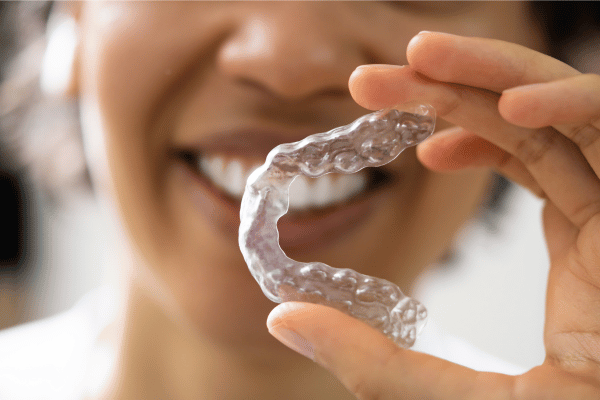
Embark on a teeth straightening journey with either braces or clear aligners to get the smile you have always wished for. Orthodontic treatments have made it easier for individuals to align their teeth. While both orthodontic treatments offer promising results with teeth straightening, they also include short-term discomfort. However, you must be wondering how long does the pain last? Discover the pain duration with braces or aligners in the guide along with some strategies to cope with the discomfort.
Understanding Pain Duration
Clear aligners and braces are both known treatments for treating malocclusions and teeth straightening. Both treatments are widely popular among individuals. Patients can experience different advantages and disadvantages with both types of treatments. When it comes to orthodontic treatments, the first thing patients wonder is the amount of pain they would have to bear. Get a complete understanding of pain in orthodontic treatments; braces or clear aligners below.
Braces
Traditional braces are the long-known orthodontic treatment for teeth alignment. They contain external objects like metallic brackets and wires on the surface of teeth. They apply pressure to teeth to bring about the desirable change. With the initiation of the treatment, the insertion of objects can lead to irritation and discomfort that could last for a couple of days to even weeks. The pain is somewhat relieved when the patient gets used to the brackets on their teeth. However, the pain and soreness in gums and teeth are also felt every time braces are adjusted. It is severe for some patients, however, some find it minimal and cope with it. Further, the pain duration also depends on your case. In case you have a severe case, you might have a longer pain duration.
Clear Aligners

Clear aligners are custom-made plastic that are applied to the teeth. Unlike braces, they do not contain metallic brackets or wires on the tooth surface. Like braces, aligners also exert gentle pressure on teeth over time. On starting the aligner journey, your gums might feel different and the edges of the aligners might hurt or cause discomfort in the gums. The pain and discomfort is mild and does not prolong. It gradually decreases as the mouth adjusts to wearing aligners. Moreover, the pain can be coped by certain over-the-counter medications.
Factors influencing Treatment pain
The following factors contribute to influencing pain and discomfort during braces or clear aligner treatment.
Pain Threshold
The pain and discomfort experienced during the treatment varies from patient to patient. Some patients have a high pain threshold and they can easily bear the pain. Whereas some patients cannot even bear a slight pain.
Treatment Plan
The severity of your orthodontic issues and the complexity of your treatment case can impact the duration and intensity of pain and discomfort. Moreover, significant adjustments may lead to longer periods of pain and discomfort.
Strategies to cope with pain with aligners or Braces
Experiencing pain and discomfort during braces or aligner treatment is common. However, one can cope with the pain and discomfort by simply following some strategies mentioned below.
Take Pain Relievers
Orthodontic patients can look for pain relievers in case the pain gets unbearable. Pain relievers like acetaminophen and Ibuprofen are well-known for relieving pain. However, you must consult with your orthodontist before taking any medications. Also, the requirement for dosage must be followed.
Massage your Gums
Patients can opt for a simple and easy way to relieve pain or discomfort caused by braces or aligners. You can use a soft-bristled brush to massage your gums it will help to relieve pain and also will help in reducing gum diseases and other oral health issues.
Use a Cold Compress
Applying cold press to your face can help you relieve pain and reduce inflammation by numbing the area. You can apply cold press for 15-20 minutes several times a day to reduce discomfort.
Avoid Hard Food
Patients undergoing orthodontic treatments like braces or aligners are advised to have an intake of soft foods. Intake of hard foods can cause severe pain and discomfort to your brackets in case of braces. Moreover, if you have hard foods there is an increased risk that you might damage braces wires.
Consultation
In case you are facing pain or discomfort, you can always consult your orthodontist. Whenever your braces or aligners are readjusted a slight discomfort begins. Whereas, if you communicate your concerns to your orthodontist, they can guide you well to address your issues to continue a smooth treatment.
Be Patient
When it comes to orthodontic treatment, orthodontic devices are new to your mouth. It is highly essential to stay patient when you embark on a teeth straightening procedure. You are going to face some pain initially. However, these patients fade away with the span of time.
To conclude, clear aligners or braces both provide effective teeth straightening. However, patients can experience pain or discomfort with either of the treatments. The intensity of the pain and duration varies with each patient. However, the pain and discomfort can be relieved by adopting some effective strategies.
FAQs
Braces and aligners exert mild to moderate pressure on the teeth that cause slight pain and discomfort in the beginning and after adjustments. However, the pain fades away with time.
To address pain caused due to aligners or braces, you can always look forward to different pain relievers, cold compresses, or gum massages.
Aligners and braces are both effective treatments for teeth straightening. Both apply pressure to teeth to bring a desirable change. Both orthodontic treatments have their pros and cons.
On starting your clear aligner journey, you might face slight discomfort in teeth or gums. However, the pain fades away as you get used to wearing aligners.
Patient threshold and treatment plan are the factors that contribute to increased pain. Patients with severe cases might feel higher pain or discomfort as compared to mild cases.



 Australia
Australia New Zealand
New Zealand Malaysia
Malaysia English
English Portuguese
Portuguese English
English English
English English
English English
English English
English Canada
Canada